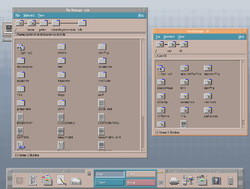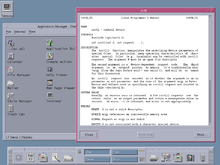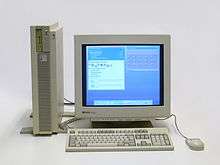Common Desktop Environment
 | |
|
CDE desktop and Application Builder, a GUI development tool | |
| Developer(s) | The Open Group (early), CDE Project (modern) |
|---|---|
| Initial release | June 1993 |
| Stable release |
2.2.4
/ June 19, 2016[1] |
| Repository |
sourceforge |
| Operating system | Unix, BSD, Linux, OpenVMS, other Unix-like OSes |
| Type | Desktop environment |
| License | LGPL v2+ |
| Website |
cdesktopenv |
The Common Desktop Environment (CDE) is a desktop environment for Unix and OpenVMS, based on the Motif widget toolkit. It was part of the UNIX98 Workstation Product Standard,[2] and was long the "classic" Unix desktop associated with commercial Unix workstations.
After a long history as proprietary software, CDE was released as free software on 6 August 2012, under the GNU Lesser General Public License, version 2 or later.[3] Since its release as free software, CDE has been ported to Linux and BSD derivatives.
Early development
Hewlett-Packard, IBM, SunSoft, and USL announced CDE in June 1993 as a joint development within the Common Open Software Environment (COSE) initiative. Each development group contributed its own technology to CDE:[4]
- HP contributed the primary environment for CDE, which was based on HP's Visual User Environment (VUE). HP VUE was itself derived from the Motif Window Manager.
- IBM contributed its Common User Access model from OS/2's Workplace Shell.
- Sun contributed its ToolTalk application interaction framework and a port of its DeskSet productivity tools, including mail and calendar clients, from its OpenWindows environment.
- USL provided desktop manager components and scalable systems technologies from UNIX System V.
After its release, HP endorsed CDE as the new standard desktop for Unix, and provided documentation and software for migrating HP VUE customizations to CDE.[5]
In March 1994 CDE became the responsibility of the "new OSF", a merger of the Open Software Foundation and Unix International;[6] in September 1995, the merger of Motif and CDE into a single project, CDE/Motif, was announced.[7] OSF became part of the newly formed Open Group in 1996.[8]
In February 1997, the Open Group released their last major version of CDE, version 2.1.[9]
Red Hat Linux was the only Linux distribution to which proprietary CDE was ported. In 1997, Red Hat began offering a version of CDE licensed from TriTeal Corporation. In 1998, Xi Graphics, a company specializing in the X Windowing System, offered a version of CDE bundled with Red Hat Linux, called Xi Graphics maXimum cde/OS. These were phased out, and Red Hat moved to the GNOME desktop.
Until about 2000, users of Unix desktops regarded CDE as the de facto standard, but at that time, other desktop environments such as GNOME and K Desktop Environment 2 were quickly becoming mature, and became widespread on Linux systems.
In 2001, Sun Microsystems announced that they would phase out CDE as the standard Solaris desktop environment in favor of GNOME. Solaris 10, released in early 2005, includes both CDE and the GNOME-based Java Desktop System. The Solaris 11 release in November 2011 only contains GNOME as a full desktop, though some CDE libraries, such as Motif and Tooltalk, remain for binary compatibility. The OpenSolaris open source project did not include CDE, and had no intent to make Solaris CDE available as open source.[10]
Systems using early CDE


- IBM AIX
- Digital UNIX
- HP-UX: from version 10.10, released in 1996.[11]
- IRIX: for a short time CDE was an alternative to IID.[12]
- OpenVMS
- Solaris: available starting with 2.3, standard in 2.6 to 10.
- Tru64 UNIX
- UnixWare
- UXP/DS
- Red Hat Linux: Two versions ported by Triteal[13] and Xi Graphics[14]
Proprietary licensing
From its launch until 2012, CDE was proprietary software.
Motif, the toolkit on which CDE is built, was released by The Open Group in 2000 as "Open Motif," under a "revenue sharing" license. That license did not meet either the open source or free software definitions. The Open Group had wished to make Motif open source, but did not succeed doing so at that time.[15]
Release under the GNU LGPL
In 2006, a petition was created asking The Open Group to release the source code for CDE and Motif under a free license.[16] On August 6, 2012, CDE was open-sourced under the LGPL free software license.[3][17] The CDE source code was then released to SourceForge.
The free software project OpenCDE had been started in 2010 to reproduce the look and feel, organization, and feature set of CDE.[18] In August 2012, when CDE was released as free software, OpenCDE was officially deprecated in favor of CDE.[19]
On October 23, 2012, the Motif widget toolkit was also released under the LGPL v2.1.[20] This allowed CDE to become a completely free and open source desktop environment.
Shortly after CDE was released as free software, a Linux live CD was created based on Debian 6 with CDE 2.2.0c pre-installed, called CDEbian.[21] The live CD has since been discontinued.
CDE project developments
In March 2014, the first stable release of CDE, version 2.2.1, was made since its release as free software.[22]
Beginning with version 2.2.2, released in July 2014, CDE is able to compile under FreeBSD 10 with the default Clang compiler.[23]
Since its release as free software, CDE has been ported to:[24]
- Linux distributions including:
- FreeBSD
- NetBSD
- OpenBSD
- OpenIndiana
- Solaris 11 (x86-64)
Future project goals of the CDE project include:
- Increased portability to more Linux, BSD, and Unix platforms.
- Further internationalization into other languages.
References
- ↑ CDE 2.2.4 released
- ↑ "Testing requirements by Product Standard". The Open Group. 31 January 2013. Retrieved 29 September 2013.
- 1 2 Thom Holwerda. "CDE released as open source". OSNews. Retrieved 2012-08-06.
- ↑ "UNIX Leaders Complete First Release of Specification for Common Open Software Environment Desktop" (Press release). Hewlett-Packard, IBM Corporation, SunSoft, Inc., UNIX System Laboratories, X/Open Company Ltd. 1993-06-30. Archived from the original on February 7, 2012. Retrieved 2014-08-19.
- ↑ Molly Joy (August 1996). "Migrating HP VUE Desktop Customizations to CDE" (PDF). Retrieved 2014-08-19.
- ↑ "Leading Vendors Unify to Accelerate Open Systems" (Press release). AT&T Global Information Systems, Digital Equipment Corporation, Hewlett-Packard Company, IBM Corporation, SunSoft Incorporated, et al. 1994-03-23. Retrieved 2008-05-15.
- ↑ "OSF Announces Formal Launch of CDE/Motif Project" (Press release). Open Software Foundation. 1995-09-07. Retrieved 2008-05-15.
- ↑ "X/Open and OSF Join to Create The Open Group" (Press release). X/Open Company Ltd. Open Software Foundation. 1996-02-14. Retrieved 2008-05-16.
- ↑ TOG Press Release: The Open Group Announces Common Desktop Environment 2.1
- ↑ "Consolidations". OpenSolaris Web site. Archived from the original on 29 July 2012. Retrieved 19 April 2015.
- ↑ HP-UX : FAQ
- ↑ IRIX 6.5 Release Notes for CDE
- ↑ "It's Here! Red Hat's TriTeal CDE, Full-Featured Unix Desktop For Linux". EE Times. Retrieved 30 October 2015.
- ↑ "DeXtop(TM) CDE Makes Big Splash in Linux Industry; Xi Graphics Inc. Releases Standardized GUI for Linux". PRNewswire. Retrieved 30 October 2015.
- ↑ "Open Motif Frequently Asked Questions". The Open Group. 2004-07-13. Retrieved 2007-11-30.
- ↑ Peter Howkins. "Petition to Open Source CDE and Motif". Retrieved 2007-11-30.
- ↑ Dave Lounsbury. "How the Operating System Got Graphical". The Open Group. Retrieved 2012-09-27.
- ↑ kpedersen. "OpenCDE". Retrieved 2011-02-14.
- ↑ woomia (6 August 2012). "CDE Open Sourced!". OpenCDE Forums.
With this, OpenCDE is officially deprecated. Feel free to make a fork of it if you wish.
- ↑ "ICS MotifZone". October 2012. Retrieved October 2012. Check date values in:
|access-date=(help) - ↑ "VecchiomagoPuntoNet: CDEbian 0.7". 2013-01-31. Retrieved 2016-01-06.
- ↑ Trulson, Jon (2014-03-01). "CDE 2.2.1 released" (Mailing list). cdesktopenv-devel. Retrieved 2014-03-05.
- ↑ Trulson, Jon (2014-07-27). "CDE 2.2.2 released" (Mailing list). cdesktopenv-devel. Retrieved 2014-07-27.
- ↑ "Common Desktop Environment: Wiki". Retrieved 2015-01-06.
External links
| Wikimedia Commons has media related to Common Desktop Environment. |
- CDE - Common Desktop Environment on SourceForge.net
- Motif on SourceForge.net
- Tutorial for CDE
- Open Group – CDE
- Party like it's 1999: CDE Unix desktop REBORN



